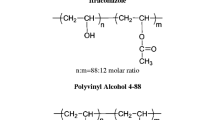Abstract
Purpose
The present study aims to determine the drug / polymer miscibility level as a function of the preparation method for an amorphous solid dispersion model system containing itraconazole and eudragit E100. This value was compared to the theoretical crystalline drug solubility in the amorphous polymer and the miscibility of the amorphous drug in the amorphous polymer.
Methods
The amorphous solid dispersions were prepared via spray drying and film casting in order to evaluate the influence of the solvent drying rate. The experimental miscibility level was estimated using XRPD, MDSC, FT-IR, HPLC and TGA. The solubility and miscibility were estimated using the Flory-Huggins mixing theory and experimental drug in monomer solubility data.
Results
The experimental miscibility level was found to be 27.5% w/w for spray-dried and 15% for film-casted solid dispersions. FT-IR measurements confirmed the absence of saturable interactions like hydrogen bonds, and analysis of the mixed glass transition temperatures suggested low adhesion forces in the amorphous mixture. The solubility analysis rendered a positive FH interaction parameter, a crystalline solubility of approximately 0.012% w/w and an amorphous drug-polymer miscibility of approximately 7.07% w/w.
Conclusion
The solid dispersions are significantly supersaturated with respect to both crystalline solubility and amorphous miscibility demonstrating the influence of manufacturing methodology.






Similar content being viewed by others
References
Leuner C, Dressman J. Improving drug solubility for oral delivery using solid dispersions. Eur J Pharm Biopharm. 2000;50:47–60.
Vasconcelos T, Sarmento B, Costa P. Solid dispersions as strategy to improve oral bioavailability of poor water soluble drugs. Drug Disc Today. 2007;12:1068–75.
Serajuddin ATM. Solid dispersion of poorly water-soluble drugs: early promises, subsequent problems, and recent breakthroughs. J Pharm Sci. 1999;88:1058–66.
Brouwers J, Brewster ME. P. augustijns. Supersaturating drug delivery systems: The answer to solubility limited oral bioavailability? J Pharm Sci. 2009;98:2549–72.
Bhugra C, Pikal MJ. Role of thermodynamic, molecular, and kinetic factors in crystallization from the amorphous state. J Pharm Sci. 2007;97:1329–49.
Yu L. Amorphous pharmaceutical solids: preparation, characterization and stabilization. Adv Drug Deliv Rev. 2001;48:27–42.
Bhattacharya S, Suryanarayanan R. Local mobility in amorphous pharmaceuticals—characterization and implications on stability. J Pharm Sci. 2009;98:2935–53.
Savolainen M, Heinz A, Strachan C, Gordon KC, Yliruusi J, Rades T, et al. Screening for differences in the amorphous state of indomethacin using multivariate visualization. Eur J Pharm Sci. 2007;30:113–23.
Surana R, Pyne A, Suryanarayanan R. Effect of preparation method on physical properties of amorphous trehalose. Pharm Res. 2004;21:1167–76.
Willart JF, Descamps M. Solid state amorphization of pharmaceuticals. Mol Pharm. 2008;5:905–20.
Peeters J, Neeskens P, Tollenaere JP, Van Remoortere P, Brewster ME. Characterization of the interaction of 2-hydroxypropyl-beta-cyclodextrin with itraconazole at pH 2, 4 and 7. J Pharm Sci. 2002;91:1414–22.
Marsac PJ, Shamblin SL, Taylor LS. Theoretical and practical approaches for prediction of drug-polymer miscibility and solubility. Pharm Res. 2006;23:2417–26.
Marsac PJ, Li T, Taylor LS. Estimation of drug-polymer miscibility and solubility in amorphous solid dispersions using experimentally determined interaction parameters. Pharm Res. 2009;26:139–51.
Six K, Leuner C, Dressman J, Verreck G, Peeters J, Blaton N, et al. Thermal properties of hot-stage extrudates of itraconazole and Eudragit E100: phase separation and polymorphism. J Therm Anal Calor. 2002;68:591–601.
Van den Mooter G, Wuyts M, Blaton N, Busson R, Grobet P, Augustijns P, et al. Physical stabilization of amorphous ketoconazole in solid dispersions with polyvinylpyrrolidone K25. Eur J Pharm Sci. 2001;12:261–9.
Six K, Verreck G, Peeters J, Binnemans K, Berghmans H, Augustijns P, et al. Investigation of thermal properties of glassy itraconazole: identification of a monotropic mesophase. Thermochim Acta. 2001;376:175–81.
Gordon S, Taylor JS. Ideal copolymers and the second-order transitions of synthetic rubbers I. Non-crystalline copolymers. J Appl Chem. 1952;2:493–500.
Kelley FN, Bueche F. Viscosity and glass temperature relations for polymer-diluent systems. J Pol Sci. 1961;50:549–56.
Simha R, Boyer RF. General relation involving the glass transition temperature and coefficient of expansion of polymers. J Chem Phys. 1962;37:1003–7.
Hancock BC, Zografi G. Characteristics and significance of the amorphous state in pharmaceutical systems. J Pharm Sci. 1997;86:1–12.
Pinal R. Entropy of mixing and the glass transition of amorphous mixtures. Entropy. 2008;10:207–23.
Couchman PR, Karasz FE. A classical thermodynamic discussion of the effect of composition on glass transition temperatures. Macromolecules. 1978;11:117–9.
Wertheim MS. Fluids with highly directional attractive forces. I. Statistical thermodynamics. J Stat Physics. 1984;35:19–34.
Wertheim MS. Fluids with highly directional attractive forces. II. Thermodynamic perturbation theory and integral equations. J Stat Physics. 1984;35:35–47.
Monograph on basic butylated methacrylate copolymer. In European Pharmacopoeia, sixth edition. Strassbourg, France, 2008, pp. 1254.
Sandler SI. Chemical & engineering thermodynamics. New York: Whiley; 1999.
Yalkowsky SH. Solubility and solubilization in aqueous media. New York: Oxford University Press; 1999. p. 49–80.
Flory PJ. Principles of polymer chemistry. Ithaca: Cornell university press; 1953.
Luder K, Lindfors L, Westergren J, Nordholm S, Kjellander R. In silico prediction of drug solubility. 3. Free energy of solvation in pure amorphous matter. J Phys Chem. 2007;111:7303–11.
Wulsten E, Kiekens F, Van Dycke F, Voorspoels J, Lee G. Levitated single-droplet drying: Case study with itraconazole dried in binary organic solvent mixtures. Int J Pharm. 2009;378:116–21.
Acknowledgements
The laboratory for pharmaceutical analysis (K.U.Leuven) is acknowledged for the FT-IR measurements, and S.J. acknowledges B.O.F., bijzonder onderzoeksfonds K.U.Leuven, for financial support (PDM grant). This study was supported by a grant from Onderzoeksraad K.U.Leuven (IOF/KP/06/021)
Author information
Authors and Affiliations
Corresponding author
Rights and permissions
About this article
Cite this article
Janssens, S., De Zeure, A., Paudel, A. et al. Influence of Preparation Methods on Solid State Supersaturation of Amorphous Solid Dispersions: A Case Study with Itraconazole and Eudragit E100. Pharm Res 27, 775–785 (2010). https://doi.org/10.1007/s11095-010-0069-y
Received:
Accepted:
Published:
Issue Date:
DOI: https://doi.org/10.1007/s11095-010-0069-y




